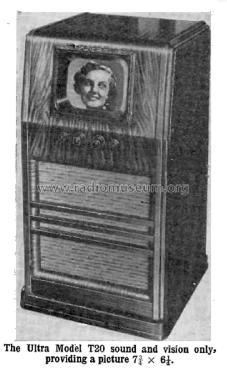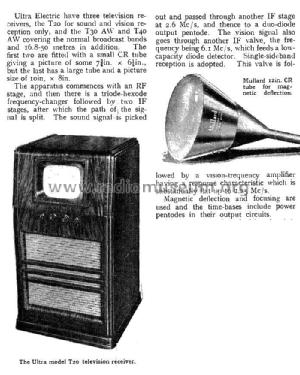Television T20
Ultra Electric Ltd.; London
- Pays
- Royaume Uni
- Fabricant / Marque
- Ultra Electric Ltd.; London
- Année
- 1937–1939
- Catégorie
- Récepteur de télévision ou moniteur
- Radiomuseum.org ID
- 345200
-
- alternative name: Ultra Radio and Television
- No. de tubes
- 15
- Lampes / Tubes
- Principe général
- Super hétérodyne avec étage HF
- Gammes d'ondes
- VHF/UHF (voir details en note)
- Tension / type courant
- Secteur (type non connu) / 200-250 Volt
- Haut-parleur
- HP mais de technologie inconnue
- Matière
- Boitier en bois
- De Radiomuseum.org
- Modèle: Television T20 - Ultra Electric Ltd.; London
- Forme
- Console de forme générique
- Remarques
-
T20, a low-priced Television Receiver for sound and vision only, with a picture size of 7¾” by 6¼”. Ediswan all-magnetic cathode-ray tube.
The apparatus commences with an RF stage, and then there is a triode-hexode frequency changer followed by two IF stages, after which the path of the signal is split. The sound signal is picked out and passed through another IF stage at 2.6 Mc/s, and thence to a duo-diode output pentode.
The vision signal also goes through another IF valve, the frequency being 6.1 Mc/s, which feeds a low-capacity diode detector. Single-sideband reception is adopted.
This valve is followed by a vision-frequency amplifier having a response characteristic which is substantially flat up to 2.25 Mc /s. Magnetic deflection and focusing are used and the time bases include power pentodes in their output circuits.
Wireless World Aug 20, 1937, Page 171.
- Littérature
- Wireless World (The), London (WW, 79) (Aug 20, 1937, Page 171.)
- Auteur
- Modèle crée par Gary Cowans. Voir les propositions de modification pour les contributeurs supplémentaires.
- D'autres Modèles
-
Vous pourrez trouver sous ce lien 235 modèles d'appareils, 153 avec des images et 149 avec des schémas.
Tous les appareils de Ultra Electric Ltd.; London

